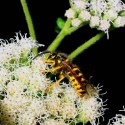A Bee or not a Bee? That is the question.
Our understanding of the natural world is often rather muddled. Calling a yellow-jacket a bee is like calling a fox a woodchuck.
“There’s a BEE on you!” My fellow teacher was hysterical. Exiting the school I brushed the yellow-jacket from my arm. Another colleague, having heard the commotion, confidently asserted that bees were endangered.
This incident gave me pause for thought. Our understanding of the natural world is often rather muddled. The “bee” on me was not a bee at all, but a wasp. And honeybees – the species my colleagues misidentified the wasp as –are not endangered.
Calling a yellow-jacket a bee is like calling a fox a woodchuck. As wasps, yellow-jackets are predators. They will visit flowers, but they also hunt soft bodied insects and spiders. Bees on the other hand are purely herbivores, with a diet consisting of pollen and nectar.
Honeybees and bumblebees beg to be sorted out as well. I cringed when a recent story on CBC about the decline of honeybees was set up by Rimsky-Korsakov’s “Flight of the Bumblebee.”
This CBC story was one of many that have appeared in the media about bee decline – both honeybee and bumblebee – over the past few years. These stories have people abuzz with the notion that bees are endangered.
Honeybees are far from endangered. They remain abundant in the meadows of the Headwaters and beyond. Declines of domestic honeybees are a concern, but feral populations seem to be thriving.
It is important to understand also that honeybees, like starlings, earthworms and scores of other common creatures, are non-native. Our trees and wildflowers did just fine without them, with pollination performed by a host of native bees and bumblebees.
Some species of these wild bumblebees have declined and we need to find out why. Asking “Is that a bee or not a bee?” would be a good starting point.
Related Stories

Bumblebees
Jul 5, 2010 | | BlogsAt this time of year when we celebrate Canada Day, Don Scallen celebrates the hardy bumblebee, the “true Canadian” of the insect world.

Flight of the Bumblebee (and other pollinators)
Jun 15, 2010 | | EnvironmentIn “Flight of the Bumblebee” Don Scallen says we owe a debt of gratitude to pollinating insects for keeping food on the tables of the human race!

Mimicry
Oct 15, 2012 | | Notes from the WildLike everything in nature, mimicry is complex and nuanced.

Pollinator Friendly Gardens
Aug 28, 2013 | | Notes from the WildWhen I walk into my yard I am greeted by a gloriously diverse menagerie of tiny winged creatures.















